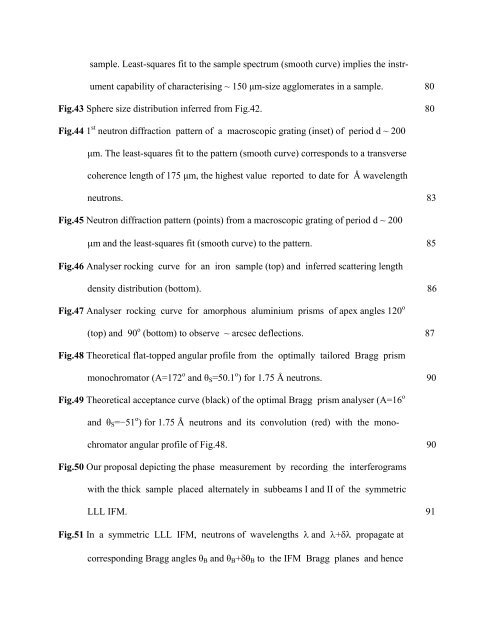PHYS01200804001 Sohrab Abbas - Homi Bhabha National Institute
PHYS01200804001 Sohrab Abbas - Homi Bhabha National Institute
PHYS01200804001 Sohrab Abbas - Homi Bhabha National Institute
You also want an ePaper? Increase the reach of your titles
YUMPU automatically turns print PDFs into web optimized ePapers that Google loves.
sample. Least-squares fit to the sample spectrum (smooth curve) implies the instrument<br />
capability of characterising ~ 150 μm-size agglomerates in a sample. 80<br />
Fig.43 Sphere size distribution inferred from Fig.42. 80<br />
Fig.44 1 st neutron diffraction pattern of a macroscopic grating (inset) of period d ~ 200<br />
μm. The least-squares fit to the pattern (smooth curve) corresponds to a transverse<br />
coherence length of 175 μm, the highest value reported to date for Å wavelength<br />
neutrons. 83<br />
Fig.45 Neutron diffraction pattern (points) from a macroscopic grating of period d ~ 200<br />
μm and the least-squares fit (smooth curve) to the pattern. 85<br />
Fig.46 Analyser rocking curve for an iron sample (top) and inferred scattering length<br />
density distribution (bottom). 86<br />
Fig.47 Analyser rocking curve for amorphous aluminium prisms of apex angles 120 o<br />
(top) and 90 o (bottom) to observe ~ arcsec deflections. 87<br />
Fig.48 Theoretical flat-topped angular profile from the optimally tailored Bragg prism<br />
monochromator (A=172 o and θ S =50.1 o ) for 1.75 Å neutrons. 90<br />
Fig.49 Theoretical acceptance curve (black) of the optimal Bragg prism analyser (A=16 o<br />
and θ S =−51 o ) for 1.75 Å neutrons and its convolution (red) with the monochromator<br />
angular profile of Fig.48. 90<br />
Fig.50 Our proposal depicting the phase measurement by recording the interferograms<br />
with the thick sample placed alternately in subbeams I and II of the symmetric<br />
LLL IFM. 91<br />
Fig.51 In a symmetric LLL IFM, neutrons of wavelengths λ and λ+δλ propagate at<br />
corresponding Bragg angles θ B and θ B +δθ B to the IFM Bragg planes and hence
















